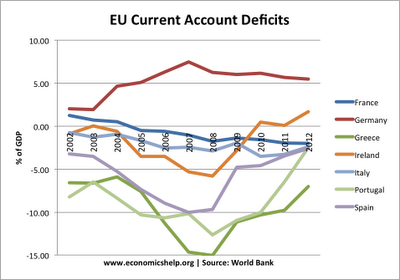UK Unemployment since 1979.
See updated post on UK Unemployment
Brief History of Unemployment in UK
After the ravages of the Great Depression era where unemployment was over 22%, unemployment in the UK remained relatively low from 1945 until the late 1970s. When Beveridge introduced the Welfare State in 1945, one thing he mentioned was the necessity of maintaining full employment. Using demand management policies and benefiting from a boom in global trade, the UK more or less achieved full employment, until the 1970s. In the 1970s, rising oil prices caused stagflation and unemployment began to rise but was still relatively low.
It was in the manufacturing recession of 1980-81 when unemployment rose to unprecedented levels. Not only did unemployment reach 3 million, but, it remained stubbornly high until 1986 well into the economic recovery. The huge rise in unemployment was due to the strong value of the Pound, high interest rates and the deflationary impact of strict monetarist policies. In particular, it was the manufacturing sector that suffered. Male full time, unskilled labour was particularly affected.
Unemployment remained high throughout the 1980s. Even at the peak of the boom in 1989, 1.6 million people were unemployed. This figure involved high rates of structural unemployment (also known as the natural rate of unemployment). This structural unemployment was because the recession of 1981 had made many unskilled workers unemployed. In the fast changing workplace, these former coal miners and ship builders struggled to get work in the new economy. Geographical unemployment was also a strong feature of the 1980s. Former areas of manufacturing and mining, struggled to cope with the large scale redundancies.
In 1991, unemployment rose again, as the economy slipped into another recession. Unemployment peaked in 1993 at just under 3 million. Unlike the 1980s, unemployment fell quicker. From the mid 1990s to 2008, UK unemployment was relatively low. Looking at official statistics, unemployment was fairly close to full employment at just over 3%.
Low unemployment was due to:
- Long period of economic growth
- Disguised unemployment, many unemployed were allowed to take sickness and disability benefits. Therefore, they are not counted as unemployed. See also: What is True Level of Unemployment?
- The Labour Force survey has consistently been higher than the government record of people on Job seekers allowance. This reflects the fact it is very difficult to get benefits these days. Some unemployed are not eligible for benefits for a variety of reasons.
- Regional Recovery. Former depressed areas like South Wales and the North East have been relatively successful in finding new industries to replace the old heavy manufacturing.
- New Deal. Better education and training for the unemployed to get back to work.
This shows that unemployment is highly cyclical. When the economy goes into recession, unemployment typically has increased to 3 million.
Unemployment during great recession.
Unemployment rose in the great depression, but was still lower than in previous recessions. For more on unemployment in this period see: the UK unemployment mystery.









